Research on Characteristics of Copper Foil Three-Electrode Planar Spark Gap High Voltage Switch Integrated with EFI
Abstract
:1. Introduction
2. Design and Fabrication of a Three-Electrode Planar Spark Gap High-Voltage Switch Based on Copper Foil
2.1. The Design of Switches
2.2. Switch Fabrication and Characterization
3. Research on the Characteristics of High-Voltage Switching with Three-Electrode Plane Spark Gap
3.1. Test Device and Principle
3.2. Static Self-Breakdown Characteristics
3.3. Dynamic Operating Characteristics
3.3.1. Dynamic Minimum Trigger Voltage
3.3.2. Switch Dynamic Conduction Performance
3.3.3. Switch Dynamic Impedance and Inductive Reactance Characteristics
3.4. Discharge Life Characteristics of Planar Spark Gap Switch
4. Conclusions
Author Contributions
Funding
Institutional Review Board Statement
Informed Consent Statement
Data Availability Statement
Conflicts of Interest
References
- Strand, T.; Berzins, L.V.; Goosmanl, D.R. Velocimetry using heterodyne techniques. In Proceedings of the 26th International Congress on High-Speed Photography and Photonics, Alexandria, VA, USA, 20–24 September 2004; pp. 593–599. [Google Scholar]
- Prinse, W.; Scholtes, G. A Development Platform for a Microchip EFI. In Proceedings of the 52nd Annual Fuze Conference, Sparks, NV, USA, 13–15 May 2008. [Google Scholar]
- Han, K.-h.; Zhou, J.; Rec, X.; Liu, T.; Ao, C.-g.; Tong, H.-h. Effect of High Voltage Pulse Power Source Equivalent Parameter on Exploding Performance of Foil Bridge. Hanneng Cailiao/Chin. J. Energ. Mater. 2014, 22, 828–833. [Google Scholar]
- Chu, K.W.; Scott, G.L. A Comparison of High-Voltage Switches; Sandia National Labs.: Albuquerque, NM, USA; Livermore, CA, USA, 1999. [Google Scholar]
- Jim, R.D. Fireset for a Low Energy Exploding Foil Initiator: SCR Drive MOSFET Switch. US Patent 6138571, 31 October 2000. [Google Scholar]
- Xu, C.; Zhu, P.; Chen, K.; Zhang, W.; Shen, R.; Ye, Y. A highly integrated conjoined single shot switch and exploding foil initiator chip based on MEMS technology. IEEE Electron Device Lett. 2017, 38, 1610–1613. [Google Scholar] [CrossRef]
- Yang, Z.; Wang, K.; Zhu, P.; Liu, P.; Zhang, Q.; Xu, C.; Jian, H.T.; Shen, R.Q. A reusable planar triggered spark-gap switch batched-fabricated with PCB technology for medium-and low-voltage pulse power systems. Defence Technol. 2021, 17, 1572–1578. [Google Scholar] [CrossRef]
- Fujii, K.; Koellensperger, P.; Doncker, R. Characterization and comparison of high blocking voltage IGBTs and IEGTs under hard- and soft-switching conditions. IEEE Trans. Power Electron. 2008, 23, 172–179. [Google Scholar] [CrossRef]
- Hanks, R.L. Low-Jitter High-Power Thyristor Array Pulse Driver and Generator. US Patent 6462605 B1, 8 October 2002. [Google Scholar]
- Salyers, P. Guided MLRS electronic safety & arming devices (ESAD) & electronic safety& arming fuze (ESAF). In Proceedings of the 43rd Gun & Missile Conference, NAIA, New Orleans, LA, USA, 21–24 April 2008. [Google Scholar]
- Soto, G. Navy Overview. In Proceedings of the 59th Annual Fuze Conference, Charleston, SC, USA, 4 May 2016. [Google Scholar]
- Graham, R.A. Shock-induced electrical switching in polymeric films. In Mega-Gauss Physics and Technology; Springer: New York, NY, USA, 1980. [Google Scholar]
- Richardson, D.D. The Effect of Switch Resistance on the Ring down of a Slapper Detonator Fireset; MRL-R1004; Materials Research Laboratories: Struthers, OH, USA, 1986. [Google Scholar]
- Nerheim, E. Integrated Silicon Plasma Switch. US Patent 4840122, 20 June 1989. [Google Scholar]
- Han, K.; Deng, P.; Chu, E.; Jiao, Q. Effect of Grain Size and Micromorphology of Cu Foil on the Velocity of Flyer of Exploding Foil Detonator. Appl. Sci. 2021, 11, 6598. [Google Scholar] [CrossRef]
- Baginski, T.A.; Thomas, K.A. A Robust One-Shot Switch for High-Power Pulse Applications [EB/OL]. IEEE Trans. Power Electron. 2009, 24, 253–259. [Google Scholar] [CrossRef]
- Baginski, T.A.; Dean, R.N.; Wild, E.J. Micromachined planar triggered spark gap switch. IEEE Trans. Compon. Packag. Manuf. Technol. 2011, 1, 1480–1485. [Google Scholar] [CrossRef]
- Zhou, M.; Meng, Q.Y.; Han, K.H.; Qian, Y.; Qin, G.S. Design and research on exploding plane switch. Initiat. Pyrotech. 2012, 12–14. Available online: https://en.cnki.com.cn/Article_en/CJFDTotal-HGPI201206005.htm (accessed on 30 December 2012).
- Wang, R.; Cheng, T.; Zhang, Y. Research on Voltage Resistance Performance of Micro-sized Exploding Foil Plane Discharge Switch. Initiat. Pyrotech. 2018, 1–4. Available online: https://caod.oriprobe.com/issues/1836321/toc.htm (accessed on 30 August 2018).
- Li, J.; Jiao, Q.; Chu, E.; Chen, J.; Ren, W.; Li, K.; Tong, H.; Yin, G.; Wang, Y.; Zhou, M. Design, fabrication, and characterization of the modular integrated exploding foil initiator system based on low temperature co-fired ceramic technology. Sens. Actuators A Phys. 2020, 315, 112365. [Google Scholar] [CrossRef]
- Xu, C.; Zhu, P.; Zhang, W.; Shen, R.; Ye, Y. A plasma switch induced by electro-explosion of p-n junction for mini exploding foil initiator. IEEE Trans. Plasma Sci. 2019, 47, 2710–2716. [Google Scholar] [CrossRef]
- Xu, C.; Zhu, P.; Wang, K.; Qin, X.; Zhang, Q.; Yang, Z.; Shen, R. An electro-explosively actuated mini-flyer launcher. Sens. Actuators A Phys. 2019, 292, 17–23. [Google Scholar] [CrossRef]
- Xu, C.; Zhu, P.; Zhang, Q.; Yang, Z.; Wang, K.; Shen, R. A shock-induced pulse power switch utilizing electro-explosion of exploding bridge wire. IEEE Trans. Power Electron. 2020, 35, 10770–10777. [Google Scholar] [CrossRef]
- Peitian, C.; Aici, Q. Review on gas switches developed for fast linear transformer driver. High Power Laser Part. Beams 2012, 24, 1263–1268. [Google Scholar] [CrossRef]
- Jiang, X.; Cong, P.; Sun, F.; Sun, T.; Liang, T.; Wei, H.; Wang, Z. Breakdown characteristics of a multi-gap gas switch with corona discharge for voltage balance. High Power Laser Part. Beams 2016, 28, 075009. [Google Scholar]
- Chen, Q.; Li, Y.; Ma, T. Characterization of the super-short shock pulse generated by an exploding foil initiator. Sens. Actuators A Phys. 2019, 286, 91–97. [Google Scholar] [CrossRef]
- Hu, B.; Jiao, J.; Zhu, P.; Wu, L.; Ye, Y.; Shen, R. Characterization of electrical explosion of schottky diode for one-shot switch applications. Eur. Phys. J.-Appl. Phys. 2014, 68, 30801. [Google Scholar] [CrossRef]
- Liu, C.; Yang, Z.; Ding, G.; Zhou, Z.; Liu, Q.; Huang, Y.; Zheng, Y. Design, simulation, and Characterization of a low-cost in-plane spark gap microswich with dual-trigger electrode for pulsed power applications. IEEE Trans Ind. Electrtonics 2013, 60, 3240–3247. [Google Scholar] [CrossRef]
- Baginski, M.E.; Shaffer, E.C.; Thomas, K.A.; McGuirk, J.S. Acomparison of the electrodynamics of metals under the action of large electric currents. Int. J. Appl. Electromagn. Mech. 2000, 11, 77–91. [Google Scholar] [CrossRef]
- Lovri, M.; Schloz, F. A model for the propagation of a redox reaction through microcrystals. Solid State Elect. Through Microcryst. 1997, 1, 108–113. [Google Scholar] [CrossRef]

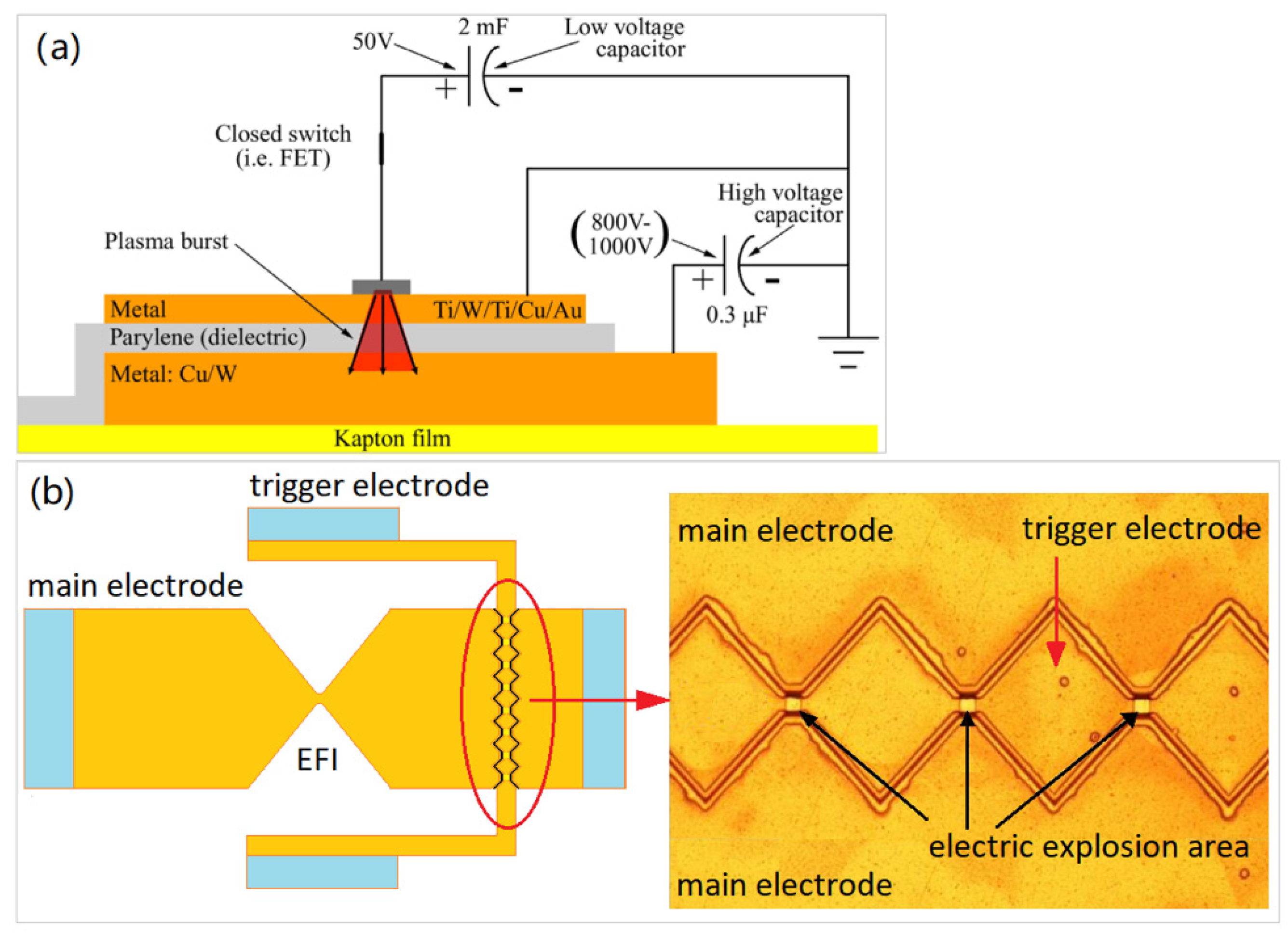
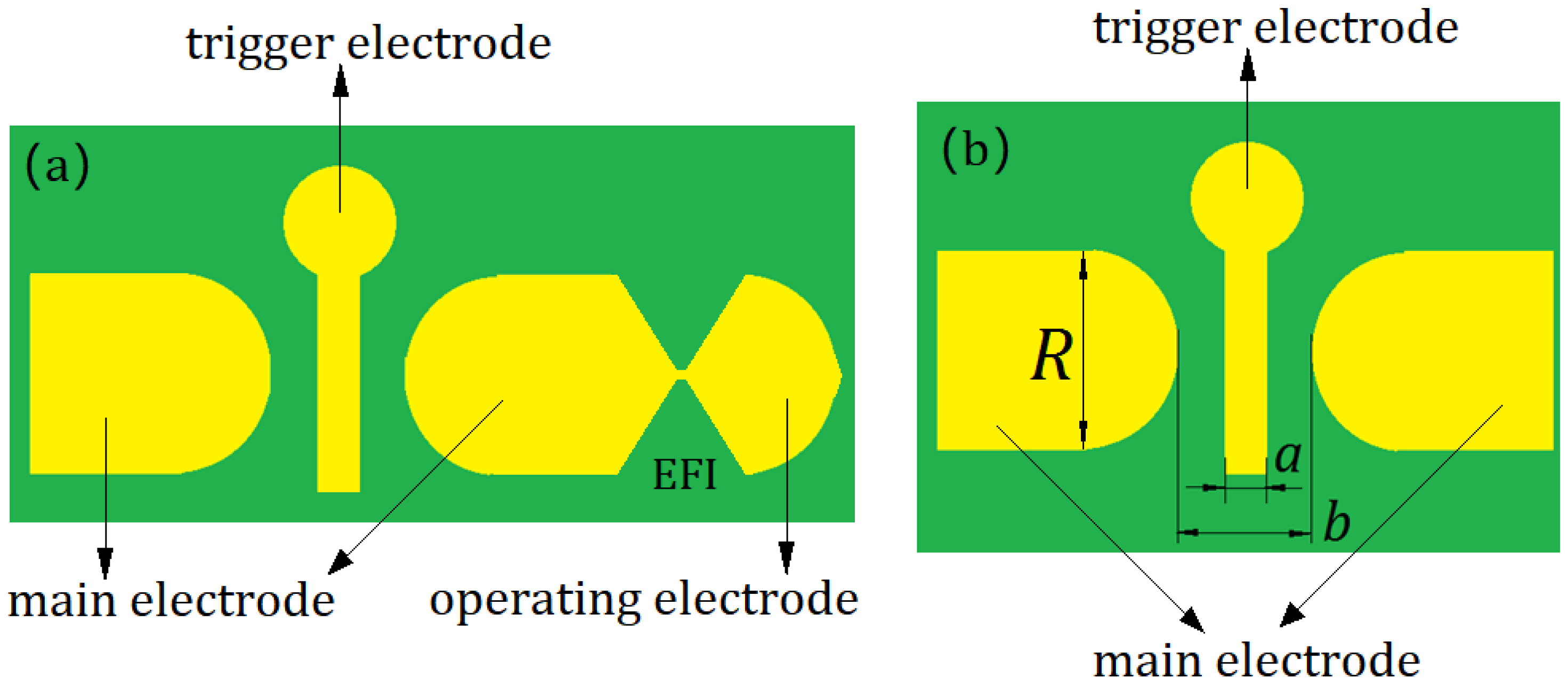
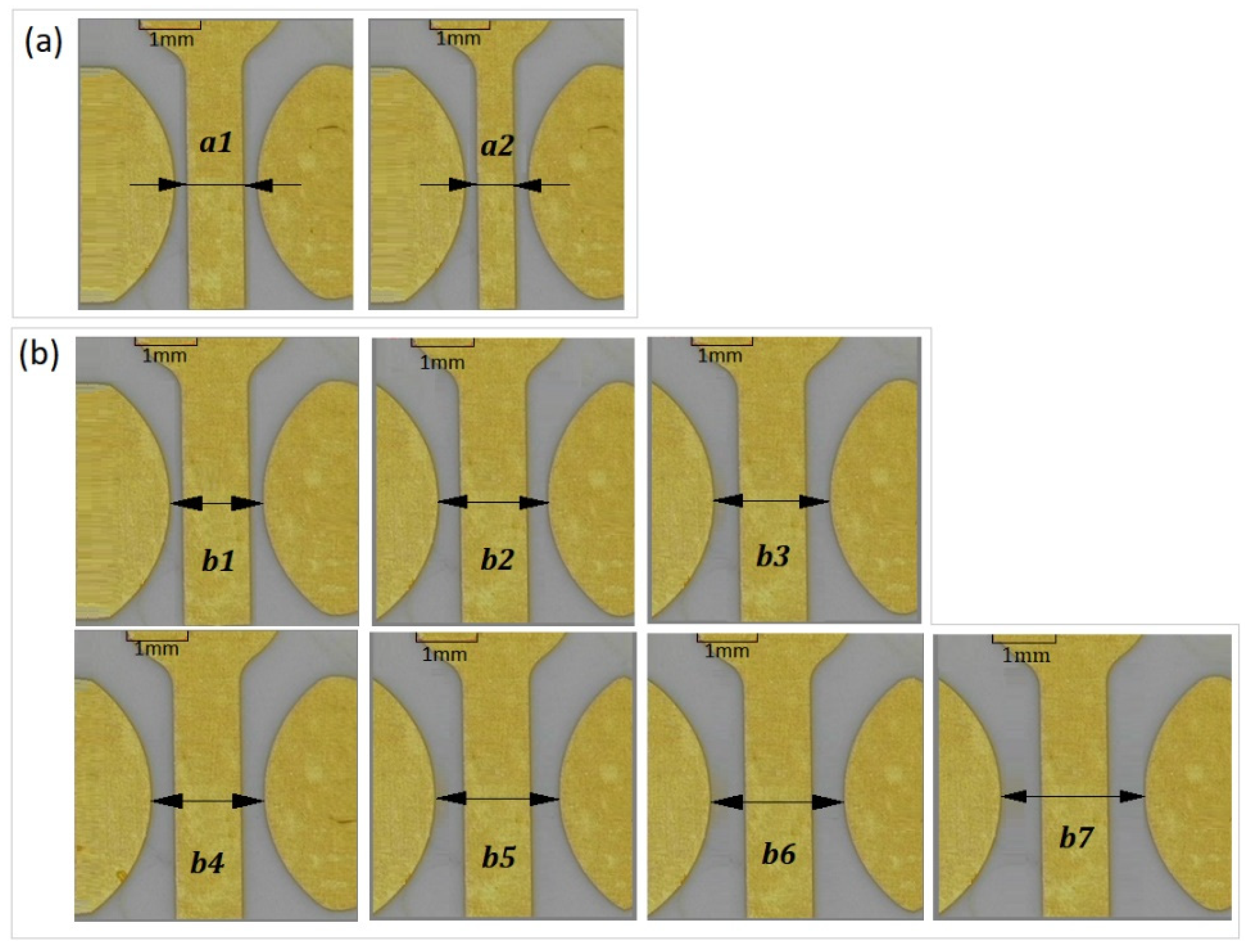
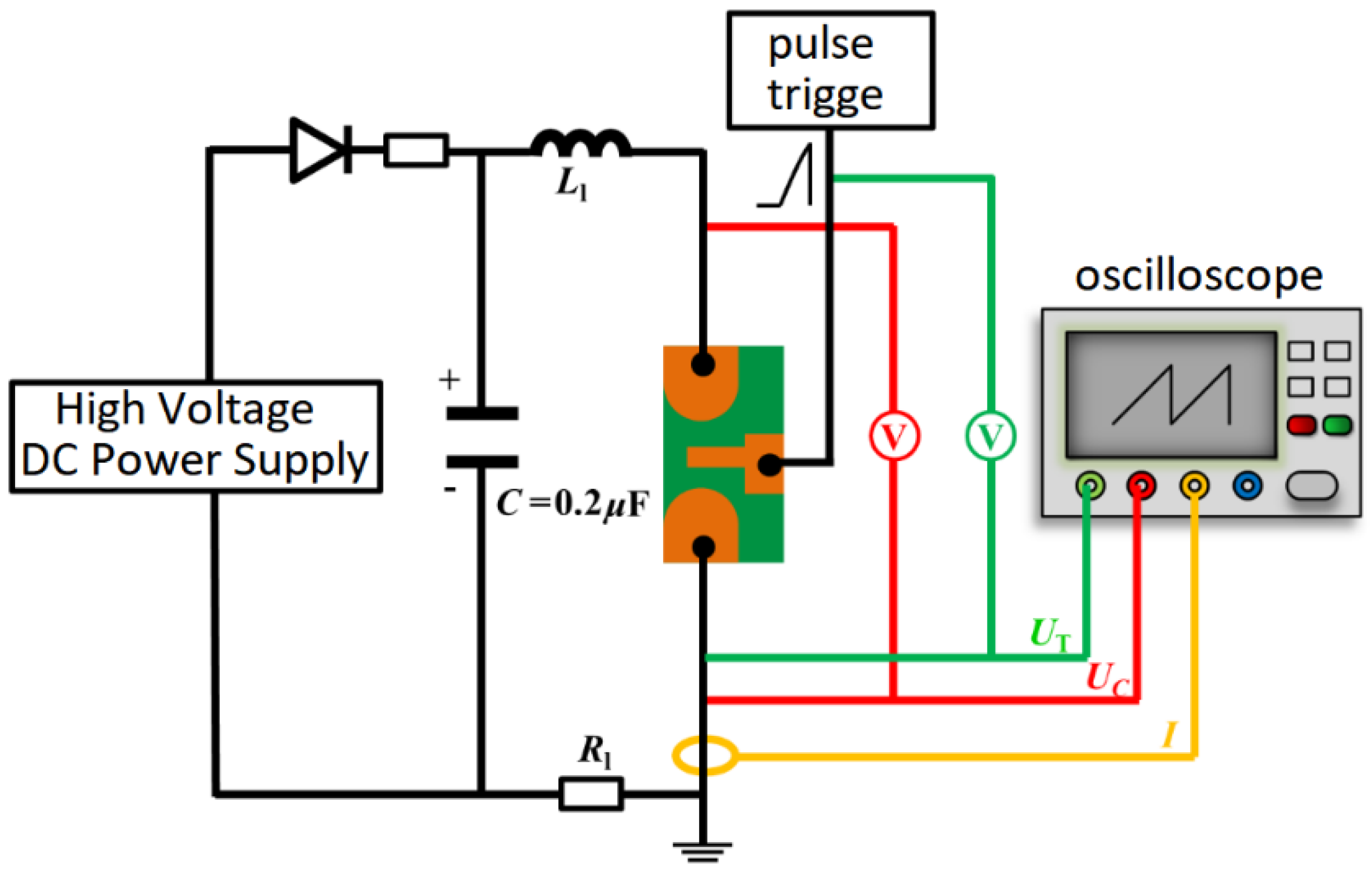
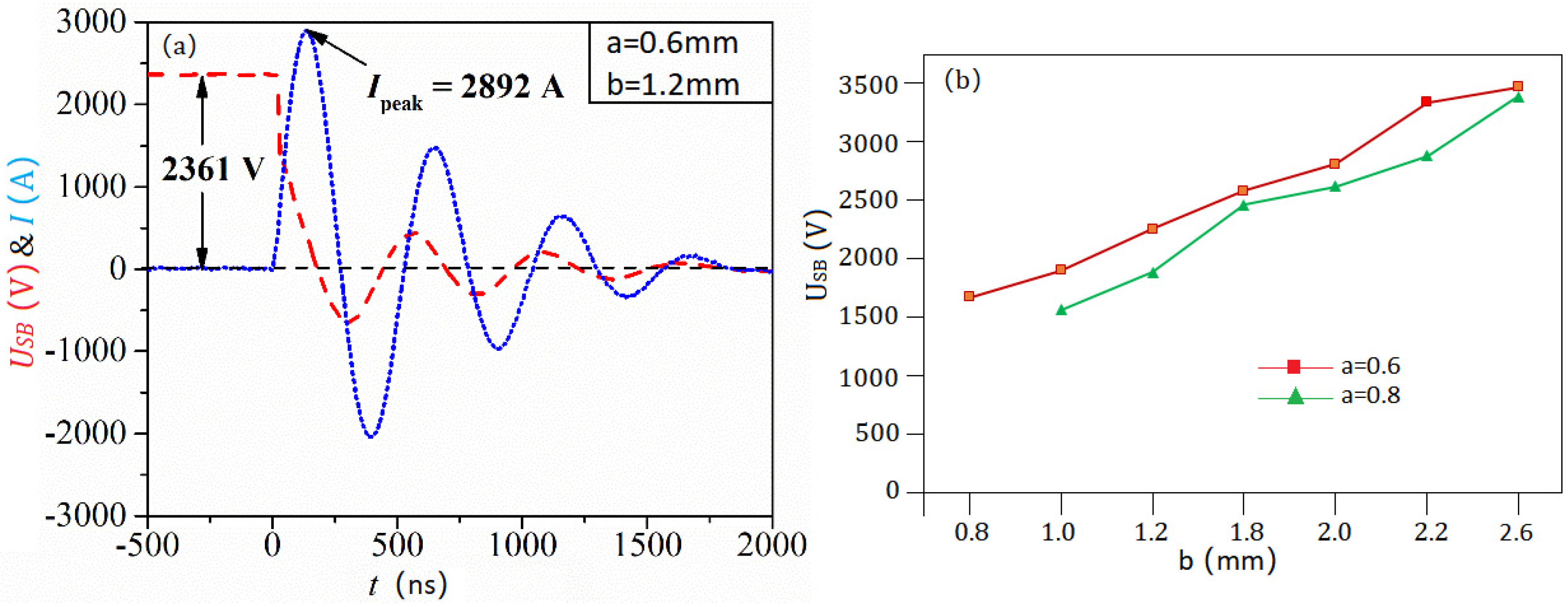
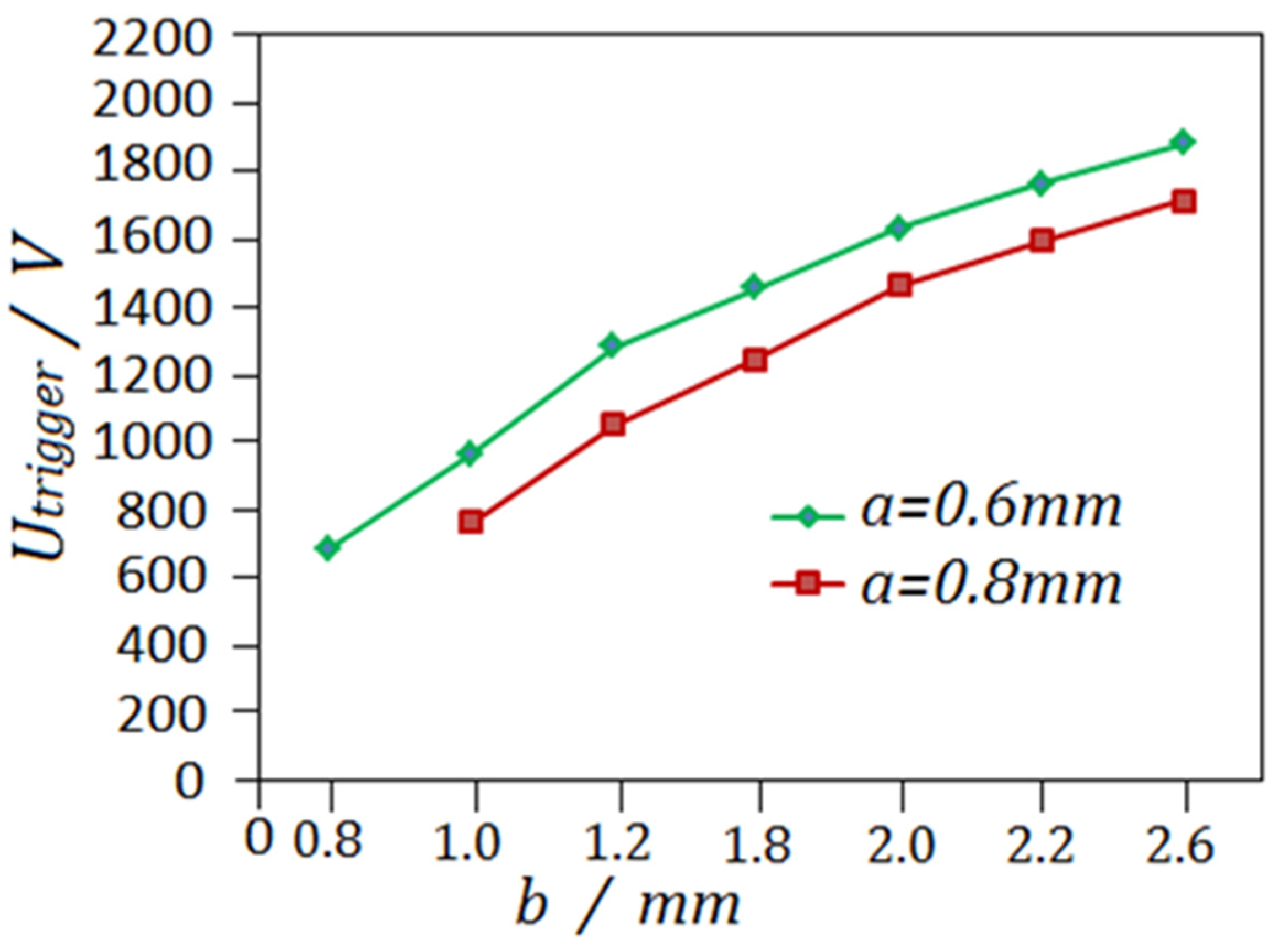
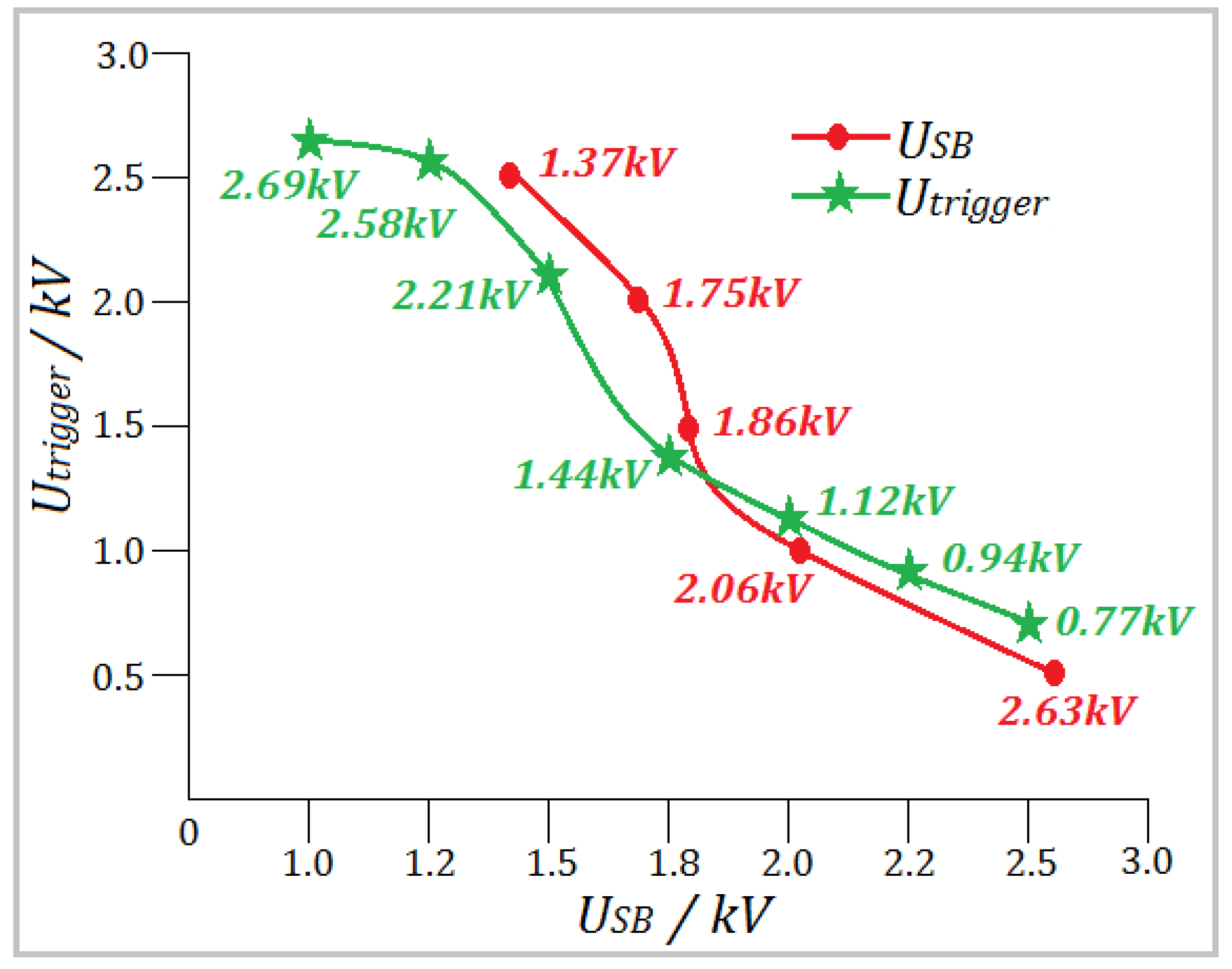

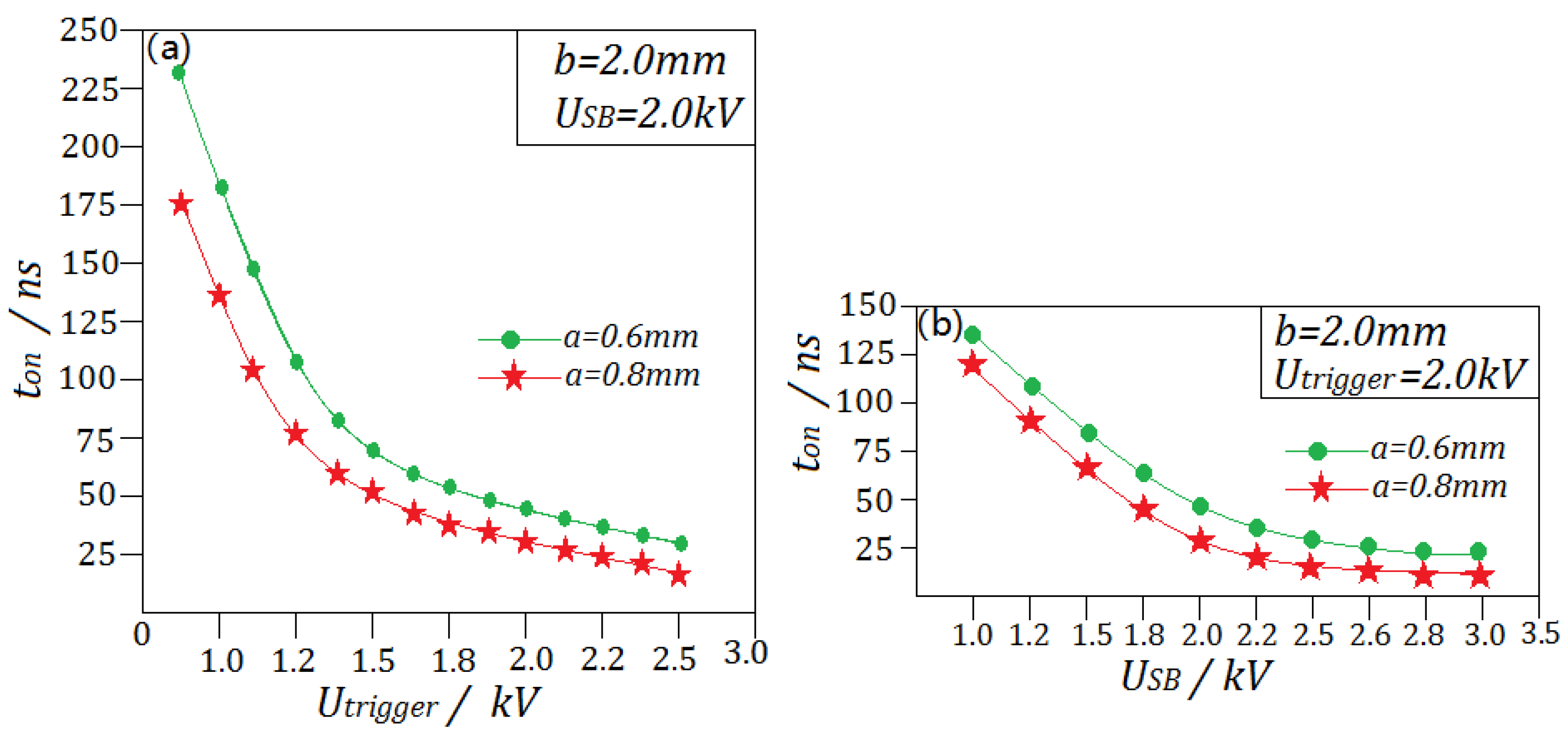
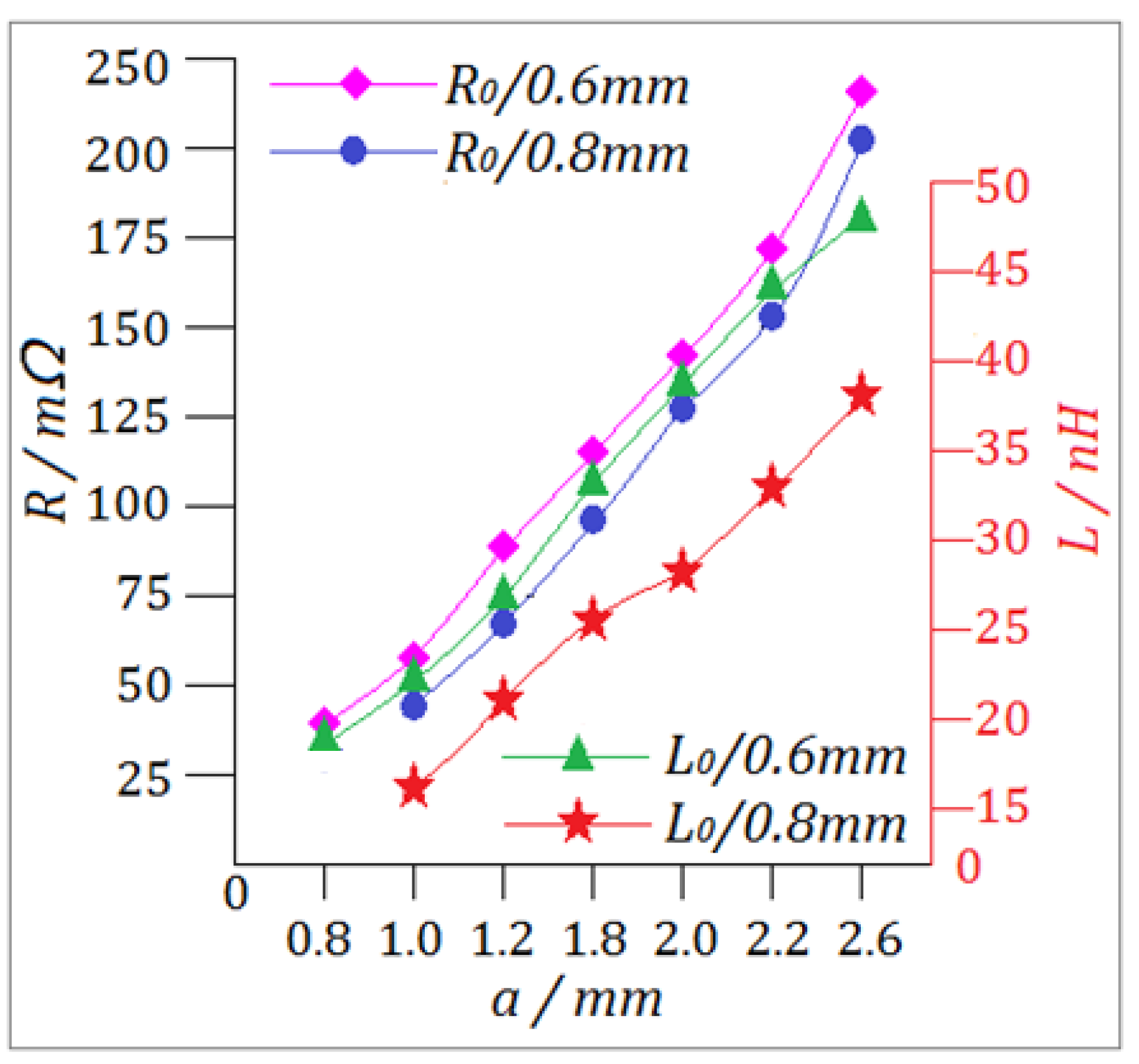

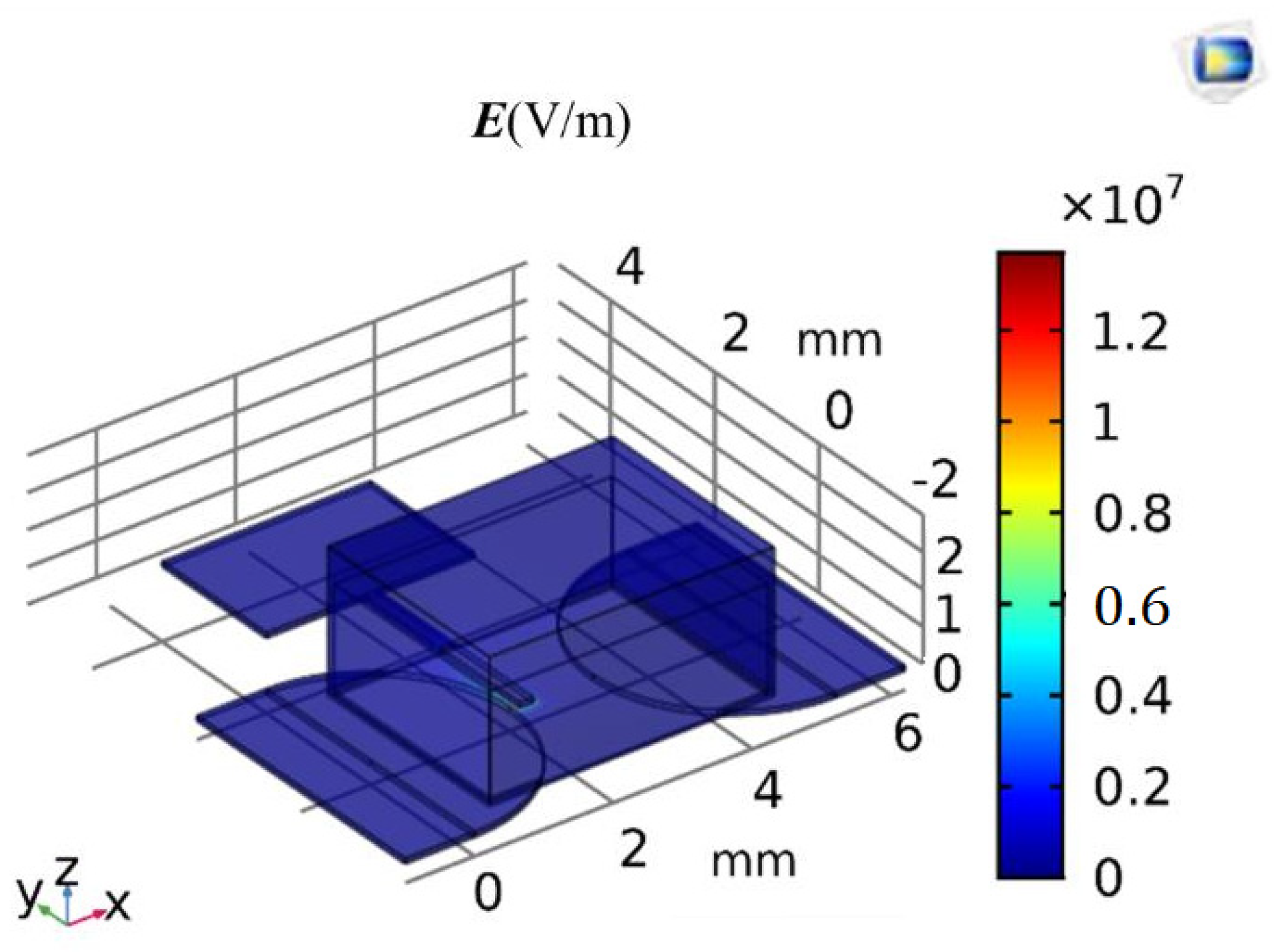
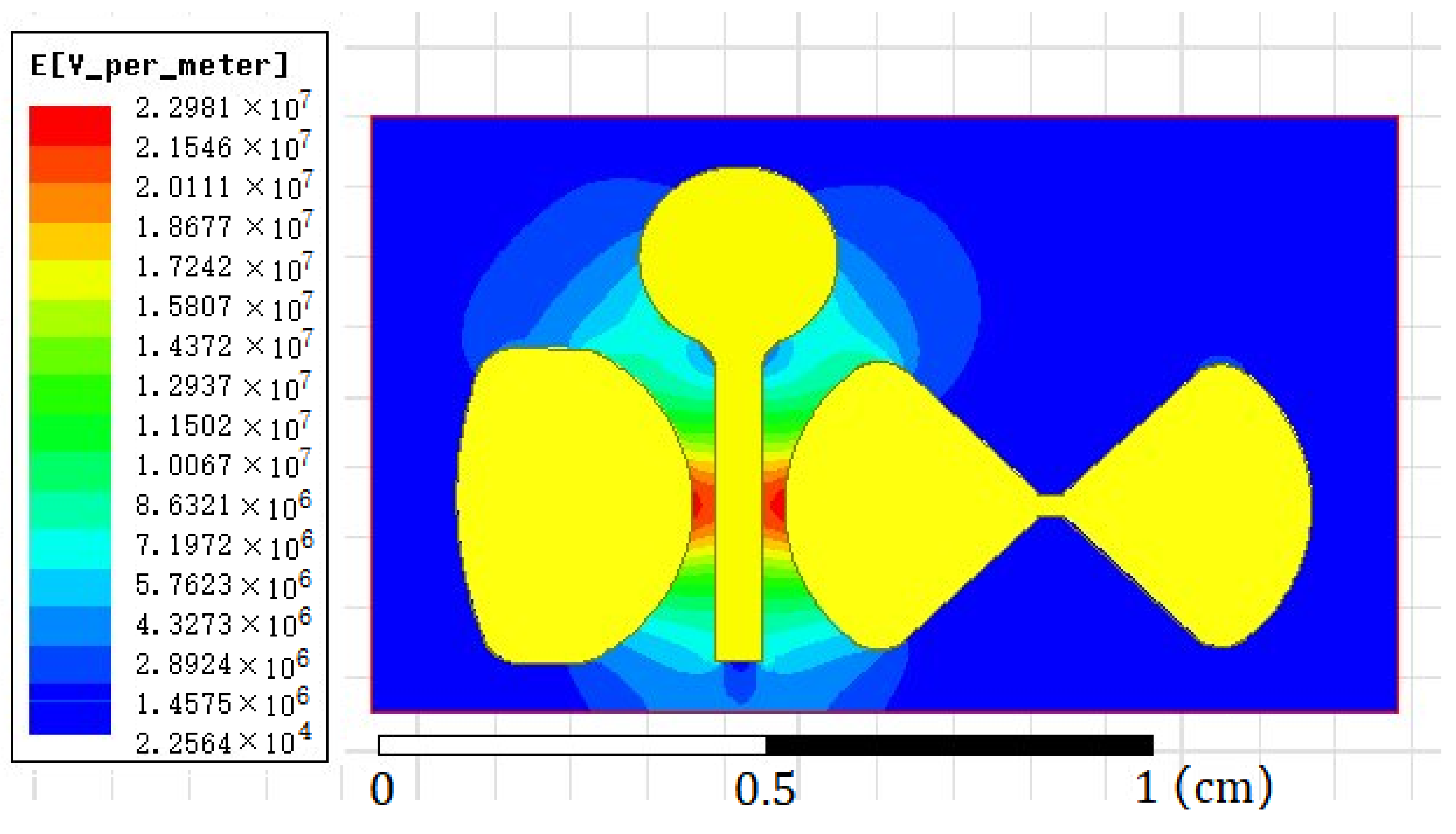
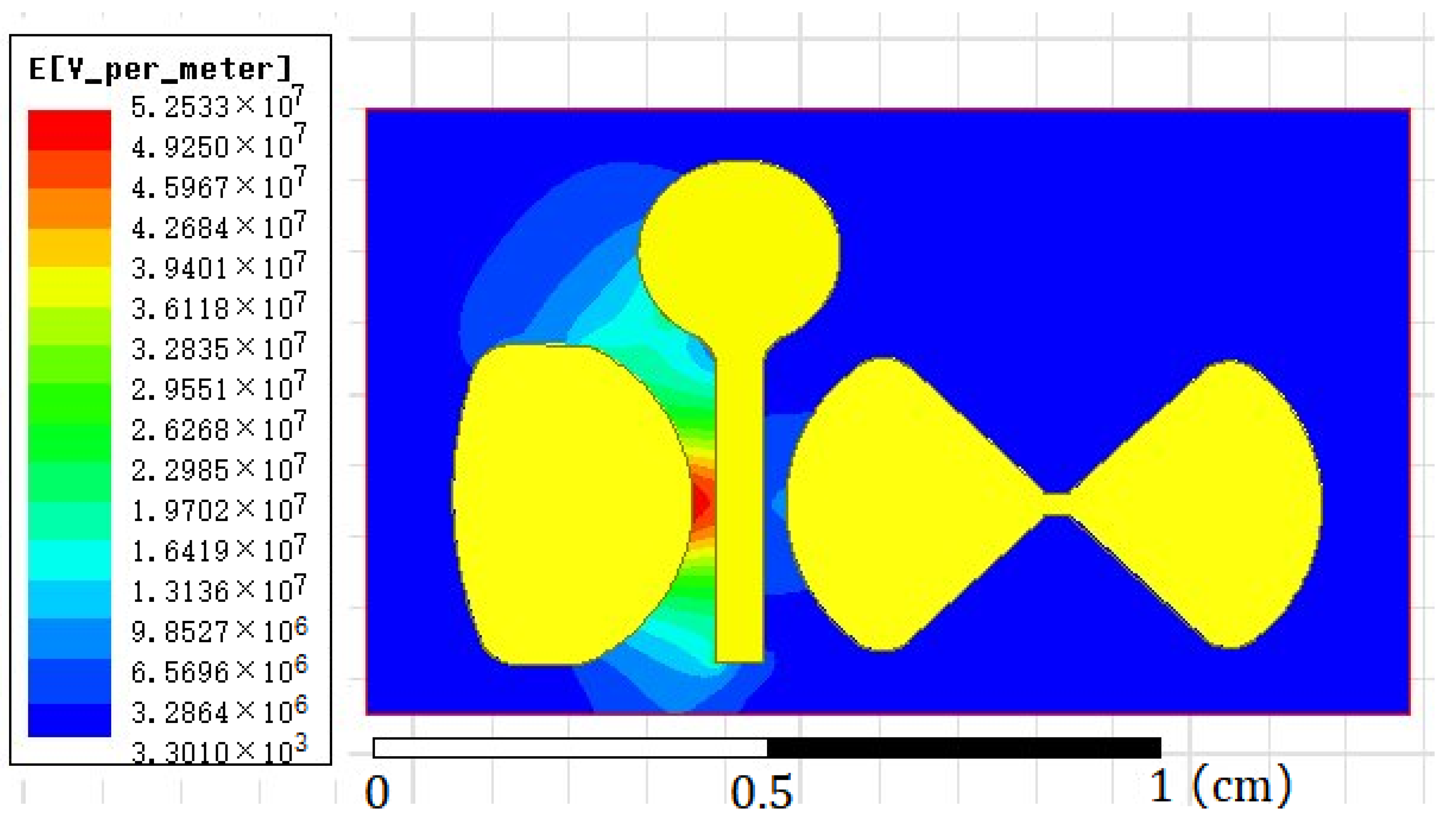
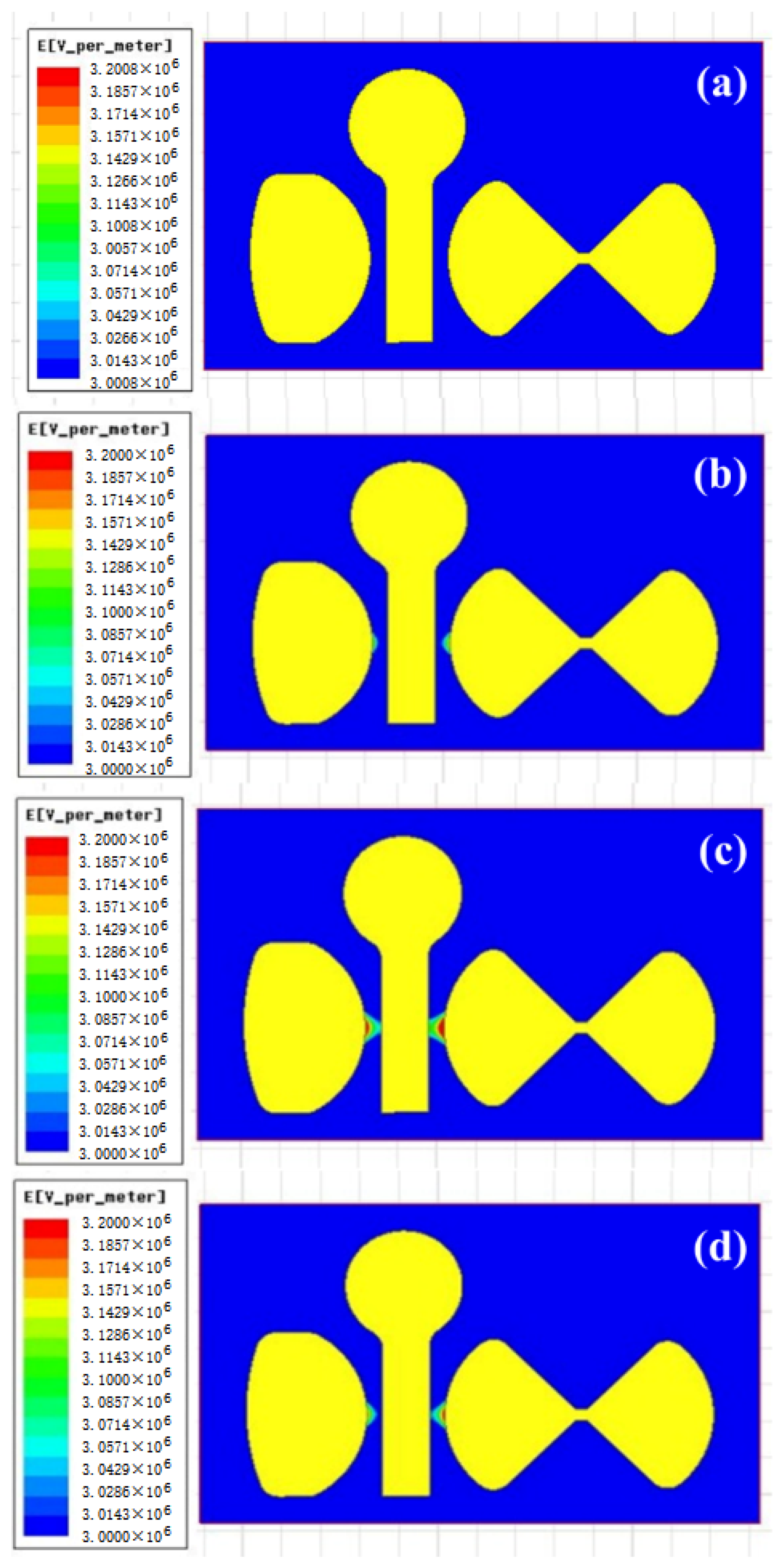
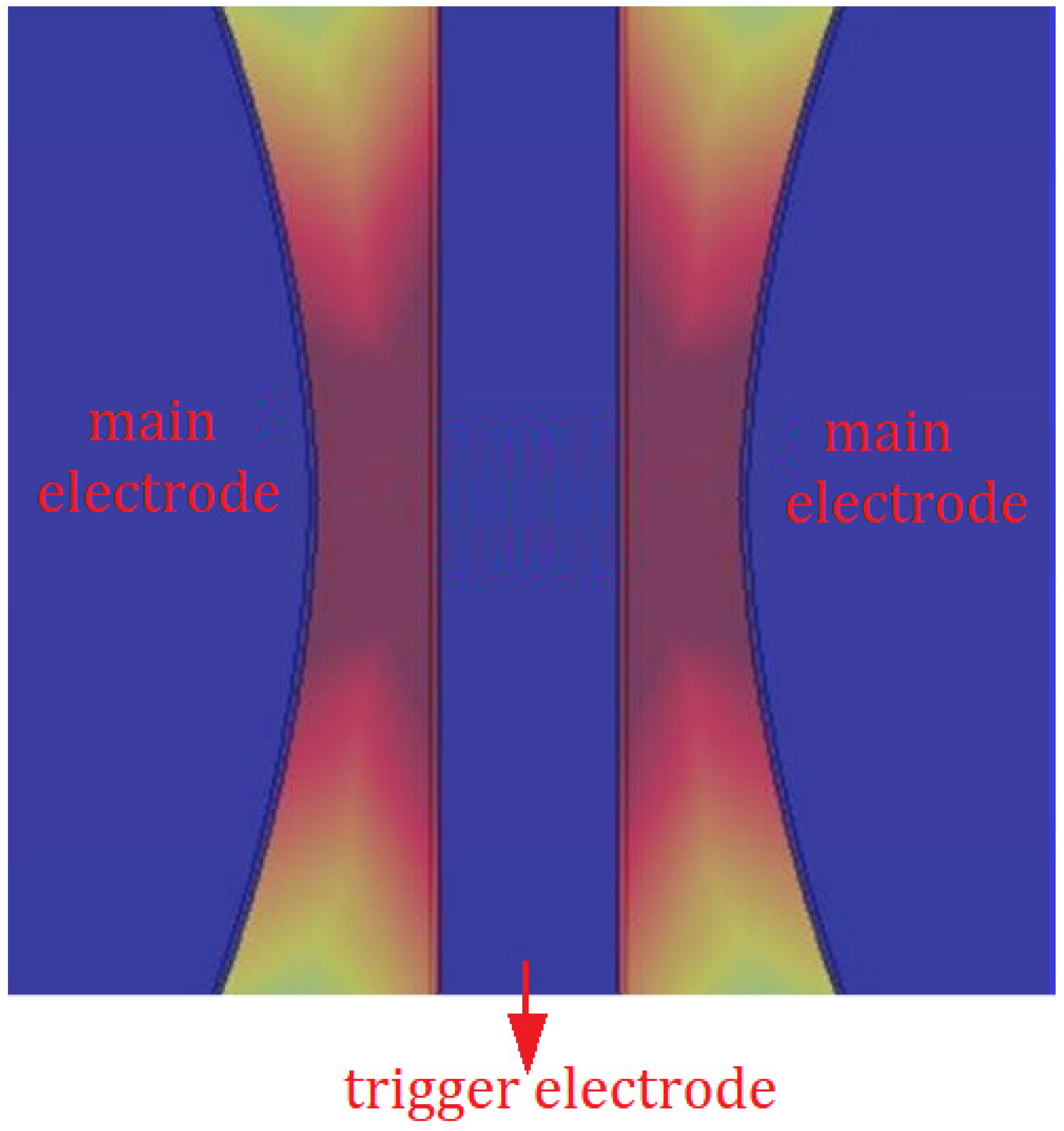
| Structure Name | Code | Parameter |
|---|---|---|
| Switch thickness | d | 4 μm ± 0.1 μm |
| main electrode radius | R | 4.0 mm ± 0.5 mm |
| main gap | b | 0.8/1.0/1.2/1.8/2.0/2.2/2.6 mm |
| Trigger electrode width | a | 0.6/0.8 mm |
| Trigger gap | (b − a)/2 | 0.1/0.2/0.3/0.6/0.7/0.8/1.0 mm |
| 0.1/0.2/0.5/0.6/0.7/0.9 mm |
| b/mm | 0.8 | 1.0 | 1.2 | 1.8 | 2.0 | 2.2 | 2.6 | |
|---|---|---|---|---|---|---|---|---|
| R0/mΩ | ||||||||
| a/mm | 0.6 | 32.8 | 51.2 | 88.4 | 117.2 | 133.1 | 171.8 | 223.9 |
| 0.8 | / | 42.7 | 68.5 | 96.7 | 127.0 | 153.9 | 207.1 |
| b/mm | 0.8 | 1.0 | 1.2 | 1.8 | 2.0 | 2.2 | 2.6 | |
|---|---|---|---|---|---|---|---|---|
| L0/nH | ||||||||
| a/mm | 0.6 | 19.3 | 21.8 | 29.4 | 33.7 | 38.2 | 42.6 | 45.3 |
| 0.8 | / | 16.6 | 19.1 | 23.5 | 26.2 | 30.2 | 37.6 |
Publisher’s Note: MDPI stays neutral with regard to jurisdictional claims in published maps and institutional affiliations. |
© 2022 by the authors. Licensee MDPI, Basel, Switzerland. This article is an open access article distributed under the terms and conditions of the Creative Commons Attribution (CC BY) license (https://creativecommons.org/licenses/by/4.0/).
Share and Cite
Han, K.; Zhao, W.; Deng, P.; Chu, E.; Jiao, Q. Research on Characteristics of Copper Foil Three-Electrode Planar Spark Gap High Voltage Switch Integrated with EFI. Appl. Sci. 2022, 12, 1989. https://doi.org/10.3390/app12041989
Han K, Zhao W, Deng P, Chu E, Jiao Q. Research on Characteristics of Copper Foil Three-Electrode Planar Spark Gap High Voltage Switch Integrated with EFI. Applied Sciences. 2022; 12(4):1989. https://doi.org/10.3390/app12041989
Chicago/Turabian StyleHan, Kehua, Wanjun Zhao, Peng Deng, Enyi Chu, and Qingjie Jiao. 2022. "Research on Characteristics of Copper Foil Three-Electrode Planar Spark Gap High Voltage Switch Integrated with EFI" Applied Sciences 12, no. 4: 1989. https://doi.org/10.3390/app12041989






